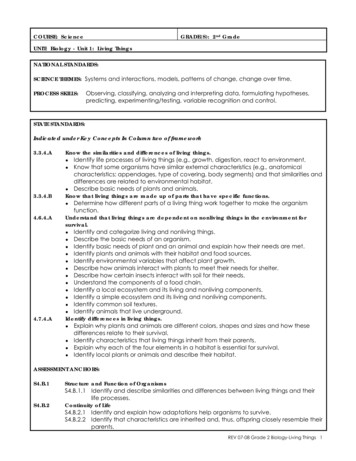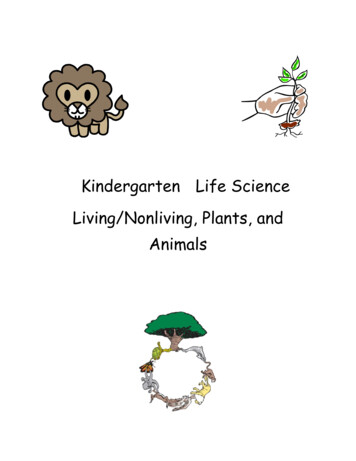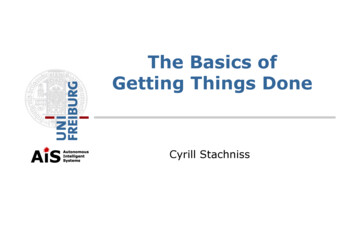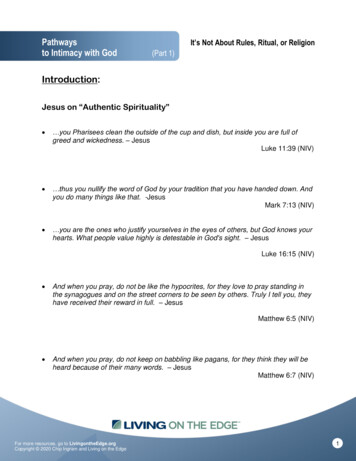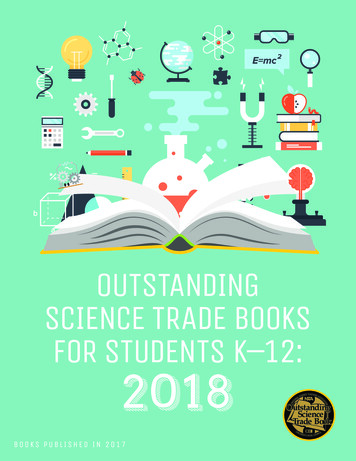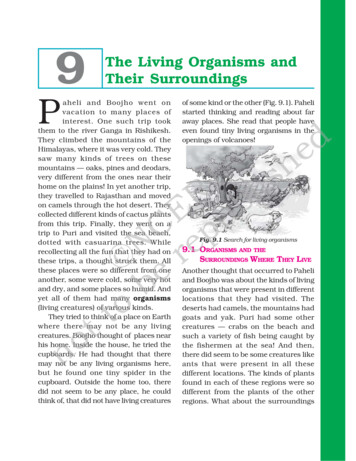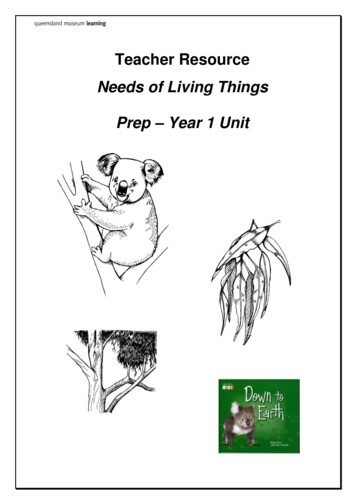
Transcription
Teacher ResourceNeeds of Living ThingsPrep – Year 1 Unit
CONTENTS1. Unit Overview .22. Lesson Plans .73. Additional Activities4. Resources .14 15The text and images in this booklet are under Creative Commons licences.All text and images are under a BY-NC-SA licence.CREATIVE COMMONS LICENCE ELEMENTSAttribution (BY)You must credit the creator, the title and the licence the work is under. Formore information on how to attribute a work, see the “How to AttributeCreative Commons Material” ibution.pdfNon-commercial (NC)Any use of the work must be for non-commercial purposes only. This meansfile sharing, educational use and film festivals are all permissible, butadvertising and for-profit uses are not.Only verbatim copies of the work may be used. In other words, you can’tchange the work in any way. You need to get extra permission if you want tocrop a photo, edit text, or use a song in a film. Basically, any remixing is notpermissible.Any new work produced using this material must be made available underthe same terms. So if you do remix a work, you have to release your newwork under the same licence. e.g. Attribution-Share Alike has to stayAttribution-Share Alike.No Derivative Works(ND)Share Alike (SA)This unit was developed by:1Adaptations Teaching Unit, Queensland Museum www.qm.qld.gov.auPaul BrandonSenior Project Officer (Primary Science)Strategic Learning, Queensland Museum2011
Science Understanding (Biological Sciences)Unit title: Needs of Living ThingsStrands: Science Inquiry SkillsStage: 1 (Year Prep - 2)Science as a Human EndeavourUNIT FOCUSWhat is the context?What do humans and other animals needto survive?What features do different animals haveto assist them in their survival?STRAND CONCEPTSFoundation YearScience UnderstandingBiological Sciences Living things have basic needs, includingfood and water (ACSSU002)the world using the senses (ACSHE013)Science Inquiry SkillsQuestioning and predicting Respond to questions about familiar objectsand events (ACSIS014)How will students demonstratetheir learning?Planning and conducting Explore and make observations by using thesenses (ACSIS011)Student work booklet.Student participation in class investigationand data collection. Identifying the needs of humans such as Literacies of science: factual text, datatables, drawings, graph (picture).Processing and analysing data andInformation Engage in discussions about observationsand use methods such as drawing torepresent ideas (ACSIS233)Communicating Share observations and ideas (ACSIS012)warmth, food and water, using students’ ownexperiences.Recognising the needs of living things in arange of situations such as pets at home,plants in the garden or plants and animals inbushland. Recognising that observation is an important Can people have a positive effect on ourwildlife?UNIT LITERACY FOCIEveryday literacies: Cooperative smallgroup work, whole class discussion,word walls and posters, PowerPointpresentations and Digital pictures,verbal reports.Science as a Human EndeavourNature and development of science Science involves exploring and observingWhat is the inquiry?ELABORATIONS part of exploring and investigating the thingsand places around usSharing observations with others andcommunicating their experiencesExploring and observing using hearing, smell,touch, seeing and taste Considering questions relating to the homeand school and objects used in everyday life. using sight, hearing, touch, taste and smell sothat students can gather information about theworld around them. Taking part in informal and guided discussionsrelating to students’ observations Using drawings to represent observations andideas and discussing their representationswith others. Working in groups to describe what studentshave done and what they have found out. Communicating ideas through role play anddrawing.Scientific literacy: knowledge andunderstanding of scientific concepts andprocesses and the application of such toeveryday situations.Examples: Drawing, factual text, graph,procedural text, report, science journal,table, word wall.
UNIT PLANNER – Needs and Features of Living ThingsUNIT FOCUSSTRAND CONCEPTSYear OneScience UnderstandingBiological Sciences Living things have a variety of externalfeatures (ACSSU017).ELABORATIONSUNIT LITERACY FOCI Recognising common features of animalssuch as head, legs and wings Describing the use of animal body parts for Living things live in different places where Exploring different habitats in the localtheir needs are met (ACSSU211) Science as a Human EndeavourNature and development of science Science involves asking questions about, including when caring for their environmentand living things (ACSHE022)environment such as the beach, bush andbackyard.Recognising that different living things live indifferent places such as land and waterExploring what happens when habitats changeand some living things can no longer havetheir needs met. Posing questions about events and features ofand describing changes in, objects andevents (ACSHE021)Use and influence of science People use science in their daily lives,particular purposes such as moving andfeedingIdentifying common features of plants such aseaves and rootsDescribing the use of plant parts for particularpurposes such as making food and obtainingwaterthe local environment that are of interest andaffect students’ lives.Recognising that descriptions of what weobserve are used by people to help identifychange. Considering how science is used in activities such as cooking, fishing, transport, sport,medicine and caring for plants and animals.Identifying ways that science knowledge isused in the care of the local environment suchas animal habitats, and suggesting changes toparks and gardens to better meet the needs ofnative animals.3
UNIT PLANNER – Needs and Features of Living ThingsUNIT FOCUSSTRAND CONCEPTSELABORATIONSUNIT LITERACY FOCIYear One - ContinuedScience Inquiry SkillsQuestioning and predicting Respond to and pose questions, and makepredictions about familiar objects and events(ACSIS024) Using the senses to explore the local Planning and conducting Participate in different types of guidedinvestigations to explore and answerquestions, such as manipulating materials,testing ideas, and accessing informationsources (ACSIS025)environment to pose interesting questions,make inferences and predictions.Thinking about “What will happen if.?” typequestions about everyday objects and events. Researching with the use of simpleinformation sources Sorting objects and events based on easilyobservable characteristics Use informal measurements in the collection Using units that are familiar to students fromand recording of observations, with theassistance of digital technologies asappropriate (ACSIS026)home and school, such as cups(cooking),hand spans (length) and walkingpaces (distance)Processing and analysing data andInformation Use a range of methods to sort information, Using simple column graphs (bar graphs) withincluding drawings and provided tables(ACSIS027) guidance from the teacher to record gatheredinformation.Using matching activities, including identifyingsimilar things, odd-one-out and opposites. Through discussion, compare observations Comparing and discussing, with guidance,Evaluating Compare observations with those of others Discussing observations with other students toCommunicating Represent and communicate observations Discussing with others what was discoveredwith predictions (ACSIS212)(ACSIS213)and ideas in a variety of ways such as oraland written language, drawing and role play(ACSIS029)whether observations were expected.see similarities and differences in results.from an investigation Presenting ideas to other students, both oneto one and in small groups4
UNIT PLANNER – Needs and Features of Living ThingsUnit title: Needs of Living ThingsStrands: Science Understanding (Biological Sciences);Science Inquiry Skills; and Science as a Human Endeavour. Stage: Prep-Year 1Time: 9 weeks (90 mins per week)PHASEACTIVITIESIntroduction of story and animals.ENGAGE(Lesson 1)Down To Earth: Introduce book Down to Earth and Read it to the class.Identification – Class Discussion: Students identify the animal characters in the story.Identify the Key animals in the Unit: Identify the Koala, Rainbow Lorikeet, Bandicoot, Squirrel Glider and Echidna that will be studied during this unit.Place animal information sheets on wall or window of classroom for students to refer to during unit.Student Work Booklet: Hand out student work books and have student’s write their name on them. Students draw a picture of themselves on the backEXPLORE(Lessons 2 )Needs of living things.EXPLAIN(Lessons 3– 5)page.Needs of living thingsWhat I Need Game: Students explore the needs of livings things through “What I Need” game.What I Need Presentation: Students engage with a PowerPoint presentation outlining what is needed and what isn’t.Reflection of Students Own Life: Students reflect on their game choices and aspects of their lives through discussion and reflections.Needs of Livings Things Presentations: The needs of livings things is explained through the use of PowerPoint presentations and class discussions.Classification: Students classify different foods, habitats and features and link them to their respective animals.Students Reflections and Communications: Students reflect on and identify these essential features in their lives and illustrate these throughdrawings in their work booklet.5
UNIT PLANNER – Needs and Features of Living ThingsStudent Investigation, data collection and analysis.ELABORATE(Lesson 6 & 7)Planning and conducting an Investigation. Can people have a positive effect on the wildlife?Planning Investigation: Students plan and conduct an investigation into a positive influents of people on bird numbers in the school by introducingnative bird seed.Question and Hypothesis: Students will hypothesis their thoughts and ideas during class discussions.Data Collection: Students will collect baseline data and then follow-up data on bird numbers using tables and digital media.Data Analysis and Communication: Students will analysis the data, compare their results with others and represent the results using a picture graphwith the assistance of their teacher and/or other staff.EVALUATE(lesson 8)Provide students opportunities to review and reflect on their learning and represent what they now know.Questioning and Reflection: Students classify items into categories of needed and wanted, and features into categories of similar to people anddifferent to people, based on the knowledge they have gained during the unit.Communicating Understanding: Students communicate their understanding of things that they can do at home or in their yard, to assist wildlifeincluding and beyond the scope of the units work.6
UNIT PLANNER – Needs and Features of Living ThingsLesson number: 1Lesson title:ENGAGE To capture students’ interest and find out what they think they know about the key concepts.Introduction of story and animals To elicit students’ questions about the key concepts.LESSON SUMMARYRESOURCESTeacher: Introduce the book “Down to Earth” by KarenCox and Steve Parish, to the class. Read the story to the class. Re-read the story asking student to stop theteacher and identify the animals on each page. Discuss what an invitation is and what it is usedfor. Ask students to describe what they havegiven or received invitations for. Write the names of each animal on a board or ina class journal. Select the Koala, Rainbow Lorikeet, Bandicoot,Echidna and Squirrel Glider to investigatefurther. Place animal information sheets on board ofwindow for class to refer to during the unit. Hand out student booklets for students to workin for the duration of the unit. Hand out animal “cut out sheet” for students tocut out the animals and stick them on the correctpage.LITERACY FOCUSESStudents will be able to: Book “Down to Earth” by KarenCox and Steve Parish. Small board or class journal. Student booklets Animals cut out sheet Glue Scissors Discuss the concept of an invitation andwhat we use them for. Students can identify the name ofselected native Australian AnimalsASSESSMENT DIAGNOSTICFind out what students already thinkthey know and understand. Thisallows you to take account ofstudents’ existing ideas whenplanning future tic:Students identify each of thenative animals in the classnarrative.Students identify the names ofthe animals and make thecorresponding connection to theimage by pasting it on thecorrect page.Students: Assist teacher during second reading to identifythe native Australian Animals on each page ofthe story. Draw a picture of themselves in student workbooklet.7
UNIT PLANNER – Needs and Features of Living ThingsLesson number: 2Lesson title:EXPLORE To provide hands-on, shared experiences.Needs of Living Things To explore the students ideas of what is needed to survive.LESSON SUMMARYRESOURCESStudents will be able to:Teachers: Tell students that they are going to play a gamecalled What I Need.Hand out “What I Need” answer sheetPlace “What I Need” cards around the room ingroups according to item.Students are to move around the room andcollect six cards in total making sure they havewhat they need to survive.Students then paste cards into their “What INeed” sheet.Students explain what is on their cards andwhy they chose that item.Watch PowerPoint 1 – Needs of Living Things.Ask students to review their work if required toinclude FOOD, HOUSE, AIR and WATER.LITERACY FOCUSES “What I Need” Student answer grid“What I Need” item cards“What I Need” InstructionsPowerPoint 1 - Needs of LivingThings. Use oral language to discuss theirideas on what is needed to survive.ASSESSMENT FORMATIVEMonitor students’ developingunderstanding and give feedbackthat extends their learning.ASSESSMENTOPPORTUNITIESVerbal reportsStudent Needs WorksheetStudents will: Play the game “What I Need”. Discuss what we really need after watchingPowerPoint 1. Ask students to review their answer sheet andmake any adjustments that they now think arerequired.8
UNIT PLANNER – Needs and Features of Living ThingsLesson number: 3Lesson title:EXPLAIN To support students to develop explanations and understanding.Needs of Living Things - FoodLESSON SUMMARYRESOURCESLITERACY FOCUSESStudents will be able to:Teacher: Read “Down To Earth” Ask the student to think of the different thingsthat some of the animals in the story might eat. Write these ideas on the board or in a classjournal Show PowerPoint 2 Needs of Living Things –Food After PowerPoint, hand out food cut outs forstudents to paste into their booklets. “Down To Earth” by Karen Cox PowerPoint 2 – Needs Of LivingThings – Food Food cut out sheet. Student work booklets Glue Scissors Use oral language to discuss theirideas on what food is needed bydifferent animals to survive.ASSESSMENT FORMATIVEMonitor students’ developingunderstanding and give feedbackthat extends their learning.ASSESSMENTOPPORTUNITIESStudents work booklet.Students will: Watch PowerPoint on the different foodsrequired by the Native Animals featured in theclass narrative. Cut out food types and paste on matching NativeAnimal’s page in work booklet Draw a picture of their favourite food.See Alternative Activities for the Explore Phaseat the end of this table.9
UNIT PLANNER – Needs and Features of Living ThingsLesson number: 4Lesson title:EXPLAIN To support students to develop explanations and understanding.Needs of Living Things - ShelterLESSON SUMMARYRESOURCESLITERACY FOCUSESStudents will be able to:Teacher: Read “Down To Earth” Ask the students to think about the types ofshelter that the native animals use. Write these ideas on the board or in theclass journal. Show PowerPoint 3 Needs of Living Things– Shelter After PowerPoint, hand out shelter cut outsfor students to paste into their booklets. “Down To Earth” by Karen Cox PowerPoint 3 – Needs Of Lining Things– Shelter Shelter cut out sheet. Student work booklets Glue Scissors Use oral language to discuss theirideas on what shelter is needed bydifferent animals to survive.ASSESSMENT FORMATIVEMonitor students’ developingunderstanding and give feedbackthat extends their learning.ASSESSMENTOPPORTUNITIESStudent work bookletStudents will: Watch PowerPoint on the different sheltersrequired by the native animals featured inthe class narrative. Cut out shelter types and paste onmatching Native Animal’s page in workbooklet Draw a picture of their house.See Alternative Activities for the ExplorePhase at the end of this table.10
UNIT PLANNER – Needs and Features of Living ThingsLesson number: 5Lesson title:EXPLAIN To support students to develop explanations and understanding.Needs of Living Things - FeaturesLESSON SUMMARYRESOURCESTeacher: Read “Down To Earth” Ask the students to think about the differentfeatures (shape of hands) between thenative animals in the book and how theyuse those features to survive. Write these ideas on the board or in theclass journal. Show PowerPoint 4 Needs of Living Things– Features After PowerPoint, hand out features cutouts for students to paste into theirbooklets.LITERACY FOCUSESStudents will be able to: “Down To Earth” by Karen Cox PowerPoint 4 – Needs Of Lining Things– Features Features cut out sheet. Glue Scissors Use oral language to discuss theirideas on what features animals haveand why they have them.ASSESSMENT FORMATIVEMonitor students’ developingunderstanding and give feedbackthat extends their learning.ASSESSMENTOPPORTUNITIESStudent work bookletStudents will: Watch PowerPoint on the different featuresof the native animals featured in the classnarrative. Cut out features and paste on matchingNative Animal’s page in work booklet Draw a picture of their hands and feet.11
UNIT PLANNER – Needs and Features of Living ThingsLesson number: 6-7(2 Weeks–15 min/day)Lesson title: Schoolyard Bird Investigation – Can people have a positive effect?ELABORATE To challenge and extend students’ understanding in a new context or make connections to additional concepts through a student-planned investigation. To support students to plan and conduct an investigation.LESSON SUMMARYRESOURCESStudents will be able to:Teacher: Introduce that concept of a Scientific Investigation. The class will investigatewhether or not people can have a positive influence on wildlife? To conduct aproper scientific investigation we need to ask a testable question (see questionabove) and make a prediction or hypothesis (What we think the answer is andwhy). Students will also need to collect information or data during the experiment. Outline experiment to the students:o Over the next two weeks students will be counting how many birdsthey see from a single location for a short amount of time (10min).o At the end of the first week we will introduce some bird feed to thearea (positive human influence) to see if the number of birdsightings increases, decreases or stays the same. (Student couldmake a bird feeder in an art lesson in class – see additionalactivities page) Assist student in selecting an observation area in the school yard (close toclassroom for ease of access and logistics) Assist student in the process of taking digital photos of birds for the survey. Assist students in classifying and collating the information.LITERACY FOCUSES Common Brisbanebirds survey sheet. Bird seed Bird feeder. Use oral language todiscuss their ideas on howpeople can have a positiveeffect on wildlife. With teacher assistanceconstruct a picture graph. Use oral language toformulate questions andhypothesis.ASSESSMENT –SUMMATIVELook for evidence of theextent to which studentshave achieved theinvestigating outcomes.ASSESSMENTOPPORTUNITIESStudents bird surveydata collection sheet.Students will: Students survey bird life in their school yard by selecting a single area toobserve from and looking for different birds for 10 min each day. To assist in the process, students may take digital photos of birds Birds sightings and numbers are to be classified into their species (eg. Magpie,pigeon, rainbow lorikeet) Students place a food source (bird seed) in the observation area on the Fridayof the first week. This food supply is to be topped up each day. Students continue to observe bird numbers during the 10 min period. Students evaluate data collected with the assistance of the teacher to see ifpeople can have a positive effect on our wildlife.12
UNIT PLANNER – Needs and Features of Living ThingsLesson number: 9Lesson title: Similar but differentEVALUATE To provide opportunities for students to review and reflect on their learning and represent what they know.LESSON SUMMARYRESOURCESStudents will be able to:Teacher: Assist students with their own personal questioning and classification of eachicon. Assist student with their own drawing of changes they could make to theirbackyard to help our wildlife.Students will: Cut out icons or features or things on the bottom of the worksheet.Classify each icon according to the two page headings.Glue to icons into the category the student thinks is the best for that icon.Draw a picture showing the things they can do in their backyard to help wildlife.LITERACY FOCUSES Needs and Wantsassessment sheet. Similar and differentassessment sheet. Classify different picturesbased on the knowledgegained throughout the unitof work. Use oral language toquestion each picture andcommunicate theirthoughts to the teacher.ASSESSMENT –SUMMATIVELook for evidence of theextent to which studentshave achieved.ASSESSMENTOPPORTUNITIESStudent Needs &Wants and Similar &Different assessmentsheets.13
UNIT PLANNER – Needs and Features of Living ThingsRESOURCES1.2.3.4.5.6.7.8.9.10.11.Additional Activity – Bird FeederCut outs for “What We Need” gameStudent worksheet for “What We Need” game.“This is my Home” fast finishers worksheetAdaptations Student Work BookletCut outs for Adaptations Student Work BookletInvestigation Planner for bird life investigationBird Survey Data Collections SheetInvestigation Picture GraphInvestigation Picture Graph IconsGuide to Making Judgements14
UNIT PLANNER – Needs and Features of Living ThingsMaking your Own Bird FeederoEquipment: 600ml-1.25L drink bottle (600ml water bottles are ideal) Skewer Scissors Marker pen String Funnel Bird seed.oMethod: Mark an arch on the side of the drink bottle (Close to the bottom) Cut out the arch (teacher assistance may be required to complete this task) Make a small hole for the skewer under the bottom of the arch and on the other side. Make three additional small holes in base of bottle for water drainage (Not too big or seedwill fall out)o Note: a cordless drill is ideal for making holes easily and safely in thebottles Insert skewer to form perch near opening Tie string around top of bottle. Tie two pieces of string on the top to allow the bottle to hangstraight and level. Fill bottom with seed and hang in tree.o Note: if using larger bottles, thicker dowel or even cheep wooden spoonscan be used for perches15
UNIT PLANNER – Needs and Features of Living ThingsA homeA homeA homeA homeA homeA homeA homeA homeA homeA homeA homeA homeA homeA homeA homeA homeA homeA homeA homeA homeA homeA homeA homeA homeA homeA homeA home16
UNIT PLANNER – Needs and Features of Living ThingsAir (oxygen)Air (oxygen)Air (oxygen)Air (oxygen)Air (oxygen)Air (oxygen)Air (oxygen)Air (oxygen)Air (oxygen)Air (oxygen)Air (oxygen)Air (oxygen)Air (oxygen)Air (oxygen)Air (oxygen)Air (oxygen)Air (oxygen)Air (oxygen)Air (oxygen)Air (oxygen)Air (oxygen)Air (oxygen)Air (oxygen)Air (oxygen)Air (oxygen)Air (oxygen)Air (oxygen)17
UNIT PLANNER – Needs and Features of Living ThingsA bikeA bikeA bikeA bikeA bikeA bikeA bikeA bikeA bikeA bikeA bikeA eamIce-cream18
UNIT PLANNER – Needs and Features of Living ysToysToysToys19
UNIT PLANNER – Needs and Features of Living ThingsGood FoodGood FoodGood FoodGood FoodGood FoodGood FoodGood FoodGood FoodGood FoodGood FoodGood FoodGood FoodGood FoodGood FoodGood FoodGood FoodGood FoodGood FoodGood FoodGood FoodGood FoodGood FoodGood FoodGood FoodGood FoodGood FoodGood Food20
UNIT PLANNER – Needs and Features of Living ThingsMacDonald’s HappyMealMacDonald’s HappyMealMacDonald’s HappyMealMacDonald’s HappyMealMacDonald’s HappyMealMacDonald’s HappyMealMacDonald’s HappyMealMacDonald’s HappyMealMacDonald’s HappyMealMacDonald’s HappyMealMacDonald’s HappyMealMacDonald’s hocolateChocolate21
UNIT PLANNER – Needs and Features of Living ThingsSoft DrinkSoft DrinkSoft DrinkSoft DrinkSoft DrinkSoft DrinkSoft DrinkSoft DrinkSoft DrinkSoft DrinkSoft DrinkSoft isionTelevisionTelevision22
UNIT PLANNER – Needs and Features of Living rWaterWaterWaterWaterWaterWaterWaterWater23
UNIT PLANNER – Needs and Features of Living ThingsWHAT I NEEDWHAT I NEEDStudent name:Student name:24
On your own paper write the names of 5 animals in the picture below,describing an adaptation of each to its particular environment. Filethis for your teacher to check.
UNIT PLANNER – Needs and Features of Living ThingsANSWER SHEET:NOTE: There is no Bandicoot in this image.26
ALL ABOUT MEName: Picture of MeMy favourite foodMy homeMy handsAnimalAdaptationsBookletExplore Phase
UNIT PLANNER – Needs and Features of Living ThingsThis bookbelongs to:Squirrel Glider .CLASS: 28
UNIT PLANNER – Needs and Features of Living ThingsEchidnaKoala29
UNIT PLANNER – Needs and Features of Living ThingsRainbow LorikeetNorthern Bandicoot30
HANDS AND FEETHANDS AND FEET
UNIT PLANNER – Needs and Features of Living ThingsFOODFOOD32
UNIT PLANNER – Needs and Features of Living ThingsSHELTERSHELTER33
UNIT PLANNER – Needs and Features of Living ThingsInvestigation plannerCLASS: Date:Planning the investigation(1) Question for investigation(Testable Question)(2) What do you predict will happen? Explain why.(Hypothesis)Can we have a positiveeffect on the bird life at ourschool? . . . . .(3) Things (variables) you are going to:(3.1) What will you ChangeIndependent Variable(3.2) What will you MeasureDependant VariableIncrease theamount of food(Bird Seed)available to thebirds.The number ofbirds seen in theschoolyard.(4) What equipment will you need?(3.3) What will youKeep the sameControlled Variables Location of the birdobservations Time of birdobservations Length of birdobservations.(5) Diagram of how you will set up the equipment.Bird observation sheetBird feederBird seed (suitable to native Australian birds)(6) Method: Observe and count birds sighted for one weekIntroduce bird foodContinue observations for another weekAnalyse data to see if changes occurred.34
UNIT PLANNER – Needs and Features of Living Things(7) Recording information (Data)CrowSightingsPloverSightingsBrush TurkeySightingsMinerSightingsKing gsRainbow ingsSightingsMagpieSightingsSightings35
UNIT PLANNER – Needs and Features of Living ThingsresultsNumber of Birds Seen(8) ExplainingType of Bird (NAME)36
UNIT PLANNER – Needs and Features of Living ThingsBird Icons for Survey Picture Graph:37
UNIT PLANNER – Needs and Features of Living ThingsPrep Year Science: “Needs of Living things” — Student observation checklistKnowledge andunderstandingScienceUnderstandingsScience as aHuman EndeavourBiological SciencesNature andDevelopment ofScienceLiving things havebasic needs,including food andwater (ACSSU002)Science involvesexploring andobserving theworld using thesenses(ACSHE013)Explains how thesenses of sight andsound are used toobserve birds life.Student Name:EG:Identifies thedifference betweenneeds and wants.Science Inquiry SkillsPlanning andConductingProcessing andanalysing data andinformationCommunicatingRespond toquestions aboutfamiliar objects andevents (ACSIS014)Explore and makeobservations byusing the senses(ACSIS011)Engage indiscussions aboutobservations anduse methods suchas drawing torepresent ideas(ACSIS233)Share observationsand ideas(ACSIS012)Talks about possibleanswers orexplinations to theinvestigationquestion.Uses their senses tomake observationson bird life in theschool.Talks about thegroups observations.Questioning andPredictingAdditionalCommentsParticipates inpreparing the groupobservation picturegraph.38
UNIT PLANNER – Needs and Features of Living ThingsYear One Science: “Needs of Living things” — Student observation checklistKnowledge and understandingScience as a Human EndeavourScience Inquiry SkillsScience UnderstandingsNature anddevelopment ofscienceBiological SciencesQuestioning andpredictingPlanning and conductingProcessing and analysing data andinformationUse informalmeasurements inthe collection andrecording ofobservations, withthe assistance ofdigitaltechnologies asappr
environment such as the beach, bush and backyard. Recognising that different living things live in different places such as land and water Exploring what happens when habitats change and some living things can no longer have their needs met. Posing questions about events and features of the lo

